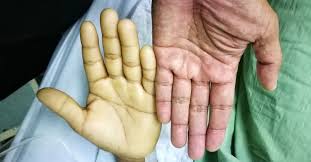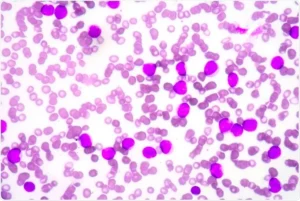
Introduction
- Aplastic anaemia ek rare aur life-threatening hematologic condition hai jisme bone marrow fail ho jata hai.
- Bone marrow jo red blood cells (RBCs), white blood cells (WBCs), aur platelets banata hai, wo damaged ho jata hai ya phir in cells ka production nahi kar pata.
- Jab bone marrow ka production kam ho jata hai, toh har type ke blood cells ki kami ho jaati hai, jise pancytopenia kaha jata hai.

Symptoms:
-
Fatigue: RBCs ki kami se oxygen supply kam ho jati hai, jiski wajah se aapko thakan mehsoos hoti hai.
-
Weakness: WBCs ki kami se immune system weak ho jata hai, aur aap easily infections se affected ho sakte hain.
-
Paleness: Anemia hone par skin pale ho sakti hai.
-
Frequent infections: Low white blood cell count se aapka body infections se ladne ki ability lose kar deta hai.
-
Bleeding tendencies: Platelets ki kami se, bleeding easily ho sakti hai, jaise easy bruising, nosebleeds, prolonged bleeding from cuts.
Aplastic anaemia ko acquired (jo zindagi mein kahin na kahin hota hai) aur inherited (jo genetics mein hota hai) types mein divide kiya ja sakta hai.
Aetiology (Causes)
Aplastic anaemia ka cause acquired aur inherited forms mein divide kiya ja sakta hai.
Acquired Aplastic Anemia
Idiopathic (Unknown Cause):
Aksar cases mein, aplastic anemia ka cause samajh mein nahi aata, aur isse idiopathic aplastic anaemia kaha jata hai. Yeh form lagbhag 50% cases mein dekhi jati hai. Yeh ek immune-mediated process ho sakta hai, jisme body ka immune system apne hi hematopoietic stem cells (bone marrow mein blood cells banane wali cells) ko attack karta hai.
Autoimmune Mechanism:
Jyada tar idiopathic aplastic anaemia mein, yeh autoimmune disorder hota hai. T-cells (jo body ke immune system ka part hain) bone marrow stem cells ko attack karte hain. Yeh immune reaction infections, drugs, ya environmental toxins ke wajah se trigger hoti hai.
Environmental aur Drug Exposures:
-
Chemicals: Benzene exposure ko aplastic anaemia se strongly link kiya gaya hai. Yeh zyada tar un logon mein dekha jata hai jo industrial chemicals ke sath kaam karte hain. Long-term exposure se bone marrow ke hematopoietic stem cells mein chromosomal abnormalities ho sakti hain.
-
Medications: Kuch specific medications jaise chemotherapy agents (cyclophosphamide), antibiotics (chloramphenicol), NSAIDs, aur anticonvulsants bone marrow ko damage kar sakte hain aur marrow failure ka karan ban sakte hain.
-
Radiation Exposure: Radiation aur X-ray exposure bone marrow ko suppress kar sakta hai, jo aplastic anaemia ke development ka karan banta hai.
Viral Infections:
Kuch viruses, jaise Hepatitis, Epstein-Barr Virus (EBV), aur Cytomegalovirus (CMV), directly bone marrow ko infect karte hain ya immune system ko activate karke marrow cells ko damage karte hain. Yeh infections aplastic anaemia ke triggers ban sakte hain.
Pregnancy:
Rare cases mein, pregnancy ke dauran bhi aplastic anaemia develop ho sakta hai. Iska exact cause unclear hai, lekin hormonal changes, immune responses, aur pregnancy ke dauran bone marrow par badhta hua stress isme contribute karte hain.
Inherited Aplastic Anaemia
Fanconi Anemia:
Yeh inherited aplastic anaemia ka sabse common cause hai. Fanconi anemia DNA repair genes mein mutations se hota hai, especially Fanconi anemia gene. Yeh ek autosomal recessive disorder hai, jisme dono parents ko gene pass karna padta hai taaki baccha is disease se affected ho. Fanconi anemia ke patients mein leukemia aur solid tumors develop hone ka high risk hota hai.
Shwachman-Diamond Syndrome:
Yeh genetic condition SBDS gene mein mutation se hota hai. Isme patients ko bone marrow failure hota hai aur unhe pancreatic insufficiency bhi ho sakti hai, jisse malabsorption aur growth retardation ho sakti hai.
Dyskeratosis Congenita:
Yeh inherited disorder telomere maintenance ko regulate karne wale genes mein mutations se hota hai. Isse premature telomere shortening hota hai, jo bone marrow failure aur systemic manifestations jaise skin pigmentation changes aur nail abnormalities ko lead karta hai.
Epidemiology (Prevalence)
Aplastic anaemia ek rare disorder hai, lekin iska incidence age, location, aur environmental factors par depend karta hai. Yeh approximately 2-5 cases per million people per year dekha jata hai.
Age:
Yeh young adults (ages 15-25) aur older adults (60+ years) mein zyada common hai, lekin kisi bhi age group mein ho sakta hai.
Geographic Variation:
Aplastic anaemia ka prevalence kuch regions mein zyada ho sakta hai, jaise industrialized areas jahan chemical exposure ya poor healthcare systems hote hain.
Gender:
Aplastic anaemia ka gender distribution mostly equal hota hai, lekin inherited forms jaise Fanconi anemia zyada tar childhood ya adolescence mein diagnose hote hain.
Pathophysiology (Mechanism)
Aplastic anaemia mein bone marrow ka failure hota hai, jisme marrow sufficient blood cells produce nahi kar pata.
Bone Marrow Hypocellularity:
Bone marrow biopsies mein hypocellularity dekhi jaati hai, matlab marrow mein hematopoietic cells ki kami hoti hai. Iske sath fat cells aur fibrosis bhi badh jaati hai.
Immune-Mediated Destruction:
Acquired aplastic anaemia mein, T lymphocytes marrow ke hematopoietic stem cells ko attack karte hain. Yeh destruction pancytopenia ka karan banta hai, jisme RBCs, WBCs aur platelets ki kami ho jaati hai.
Genetic Mutations:
Inherited aplastic anaemia mein DNA repair genes mein mutations se hematopoietic stem cells ko damage hota hai, jo bone marrow failure ko cause karta hai.
Laboratory Investigation
Aplastic Anaemia ka diagnosis mainly laboratory tests se hota hai. In tests ka use isliye kiya jata hai taaki blood cells ki kami ko assess kiya ja sake aur bone marrow ki functionality ko evaluate kiya ja sake. Sabse important tests aur unke findings niche diye gaye hain:
1. Complete Blood Count (CBC) with Reticulocyte Count
Complete Blood Count (CBC):
CBC ek basic aur essential test hai jo blood cells ke count ko measure karta hai. Aplastic anaemia mein aapko pancytopenia dekha jayega, yani RBCs, WBCs, aur platelets teenon ki kami.
-
Anemia: RBCs ki kami ke wajah se hemoglobin levels low honge, jo fatigue, paleness aur breathlessness ka cause ban sakta hai.
-
Leukopenia (Neutropenia): WBCs, especially neutrophils, ki kami se infection ka risk badh jata hai.
-
Thrombocytopenia: Platelets ki kami se bleeding tendencies badh jati hain, jaise bruising, nosebleeds, aur prolonged bleeding.

Reticulocyte Count:
Yeh immature RBCs ko measure karta hai. Aplastic anaemia mein, reticulocyte count low hota hai, jo yeh indicate karta hai ki bone marrow effectively RBCs produce nahi kar raha.
2. Peripheral Blood Smear
Peripheral Blood Smear:
Is test mein blood sample ko microscope ke under examine kiya jata hai. Aplastic anaemia mein smear par yeh findings ho sakti hain:
-
Normocytic aur Macrocytic RBCs: RBCs size mein normal ya thoda bada ho sakte hain.
-
Few or No Reticulocytes: Bone marrow mein RBCs ki production thodi ya bilkul nahi ho rahi hoti, isliye smear mein reticulocytes bahut kam ya absent ho sakte hain.
-
Low WBCs and Platelets: WBCs aur platelets ki kami bhi smear par clearly dikhti hai.
3. Bone Marrow Biopsy and Aspiration
Bone Marrow Biopsy:
Yeh diagnostic test bone marrow ki cellularity ko assess karta hai. Aplastic anaemia mein, bone marrow hypocellular hota hai, yani blood cells ki production bahut kam hoti hai aur fat cells badh jaate hain.
Findings:
-
Hypocellular Marrow: Bone marrow mein hematopoietic cells (blood cells banane wali cells) ka number significantly kam hota hai.
-
Fatty Infiltration: Bone marrow fat se replace ho jata hai, jisse marrow mein cells ka kam hona dikhayi deta hai.
Bone Marrow Aspiration:
Yeh needle se marrow cells ko aspirate karne ka process hai, jisme bone marrow ka morphology assess kiya jata hai. Aplastic anaemia mein, bone marrow aspiration mein kam hematopoietic cells aur zyada fat cells dekhe jaate hain.
4. Flow Cytometry
Flow Cytometry:
Yeh test bone marrow mein immune-mediated damage ko analyze karta hai. Yeh test particularly acquired aplastic anaemia mein useful hota hai jahan T-cells bone marrow cells ko attack karte hain.
Findings:
-
Activated T-Cells: Flow cytometry activated T-cells ko detect karta hai, jo marrow ke hematopoietic stem cells ko damage karte hain.
-
Immune Profiling: Yeh test autoantibodies ko bhi detect kar sakta hai jo marrow cells ko target karte hain.
5. Cytogenetic Testing and Chromosomal Analysis
Cytogenetic Testing:
Agar inherited aplastic anaemia ka suspicion ho, toh genetic testing jaise karyotyping ya FISH (Fluorescence In Situ Hybridization) kiya ja sakta hai. Yeh test chromosomal abnormalities ko identify karta hai.
Findings:
-
Fanconi Anaemia: Yeh genetic condition chromosomal instability se judi hoti hai. Testing se DNA repair genes mein abnormalities detect ki ja sakti hain.
-
Telomere Analysis: Dyskeratosis Congenita jaise inherited conditions mein telomere shortening ko detect kiya ja sakta hai.
6. Viral Studies
Viral Infections:
Aplastic anaemia ka ek common trigger viral infections hote hain. Kuch viruses jaise Hepatitis, Epstein-Barr Virus (EBV), aur Cytomegalovirus (CMV) se infections ke baad aplastic anaemia develop ho sakta hai.
Viral Studies:
Viral infections ko detect karne ke liye blood tests, jaise Hepatitis B, C, EBV, aur CMV ki serology ki jaati hai. Yeh infections bone marrow suppression ka cause ban sakte hain.
7. Serology and Autoimmune Markers
Autoimmune Markers:
Agar aplastic anaemia autoimmune origin ka hai, toh serological tests se autoantibodies detect kiye ja sakte hain. Yeh markers immune system ki overactivity ko indicate karte hain.
Tests to Consider:
-
Antinuclear Antibodies (ANA): High ANA levels autoimmune diseases ko indicate karte hain, jo aplastic anaemia mein contribute karte hain.
-
Anti-Granulocyte Antibodies: Kuch cases mein aplastic anaemia mein granulocyte cells ko target karne wali autoantibodies hoti hain, jinhe flow cytometry ya immunofluorescence se detect kiya ja sakta hai.
8. Iron Studies
Iron Studies:
Iron deficiency ko rule out karne ke liye iron studies ki ja sakti hain, kyunki iron deficiency anemia ko aplastic anaemia ke symptoms se confuse kiya ja sakta hai. Aplastic anaemia mein iron levels usually normal ya elevated hote hain, kyunki RBC production kam ho jaati hai aur body ka iron effectively use nahi hota.
Treatment and Management
Supportive Care:
-
Blood Transfusions: Severe aplastic anaemia mein RBCs aur platelets ki regular transfusions ki zarurat hoti hai.
-
Infection Control: Antibiotics aur antivirals infections ko control karne ke liye diye jate hain.
Immunosuppressive Therapy:
-
Antithymocyte Globulin (ATG): Yeh T-cells ko deplete karta hai aur immune system ko suppress karta hai.
-
Cyclosporine: Yeh immune attack ko block karta hai.
Hematopoietic Stem Cell Transplantation (HSCT):
Agar donor match ho, toh stem cell transplant severe aplastic anaemia ka curative treatment hota hai.
Eltrombopag:
Yeh thrombopoietin receptor agonist hai jo blood cell production ko stimulate karta hai.
Bone Marrow Growth Factors:
Medications like G-CSF aur erythropoiesis-stimulating agents blood cell production ko stimulate karte hain.